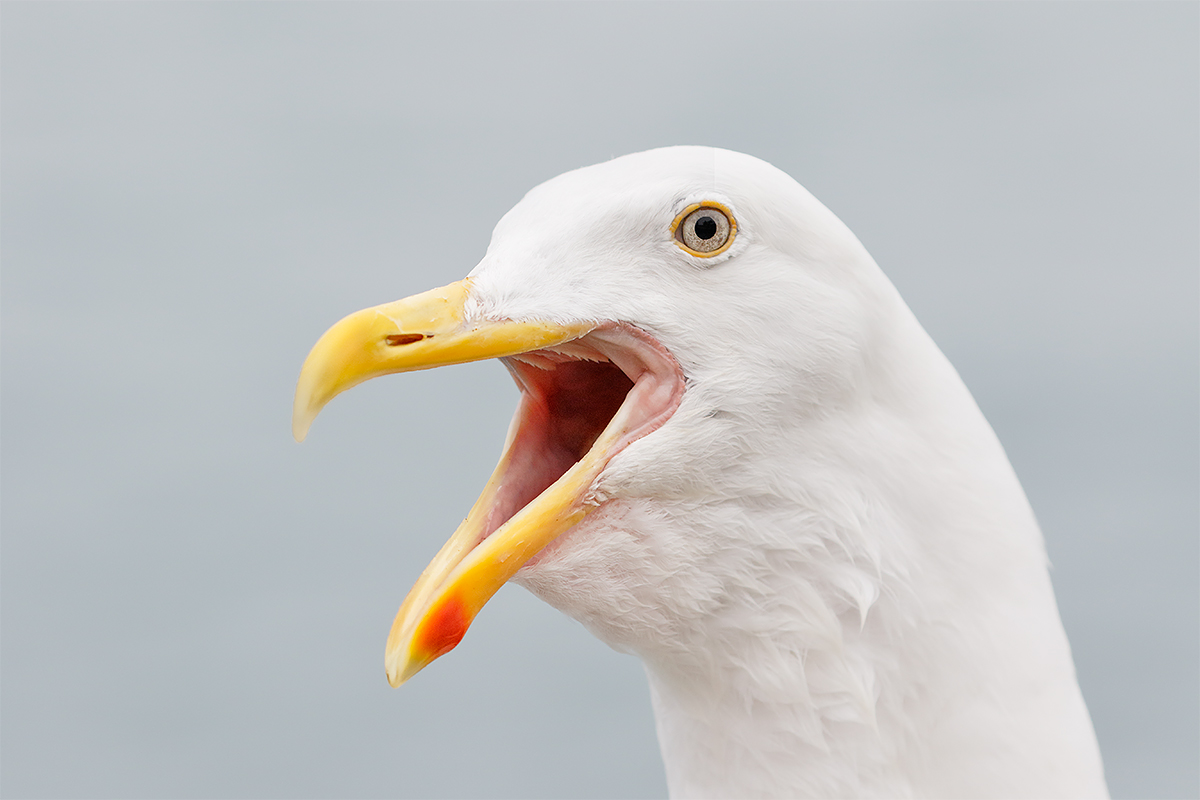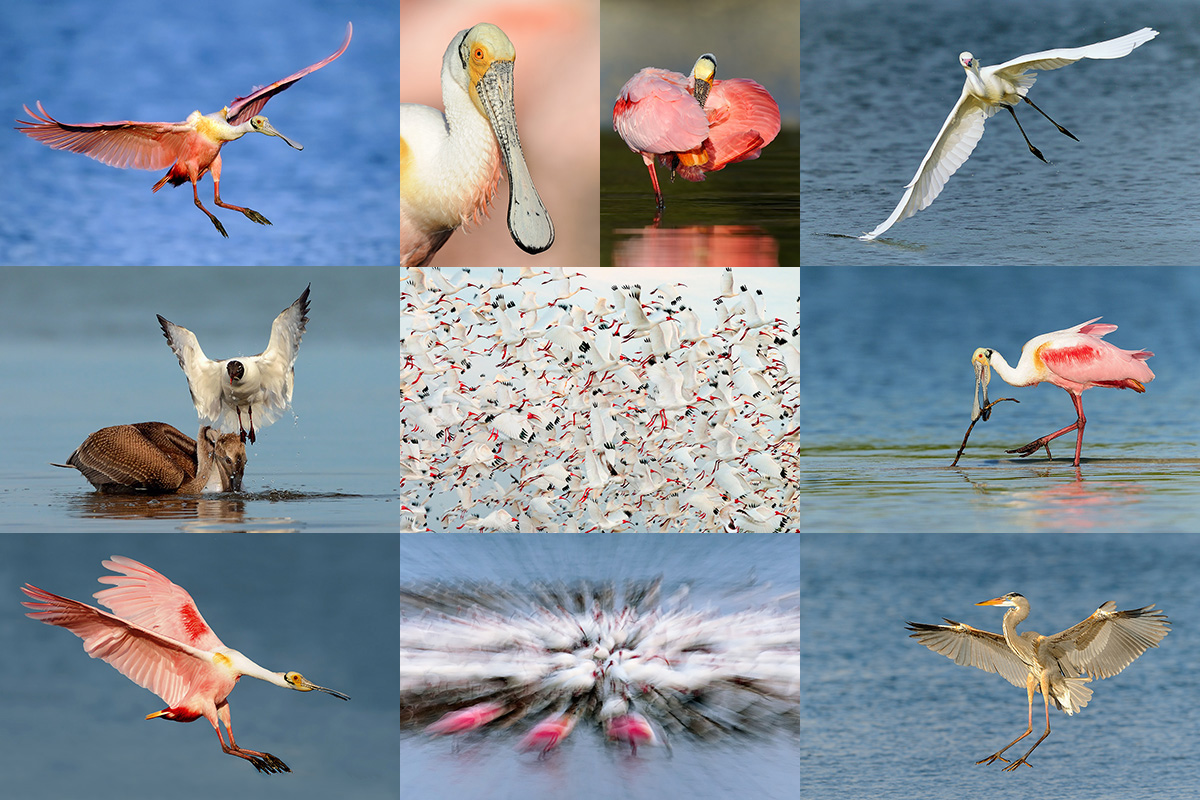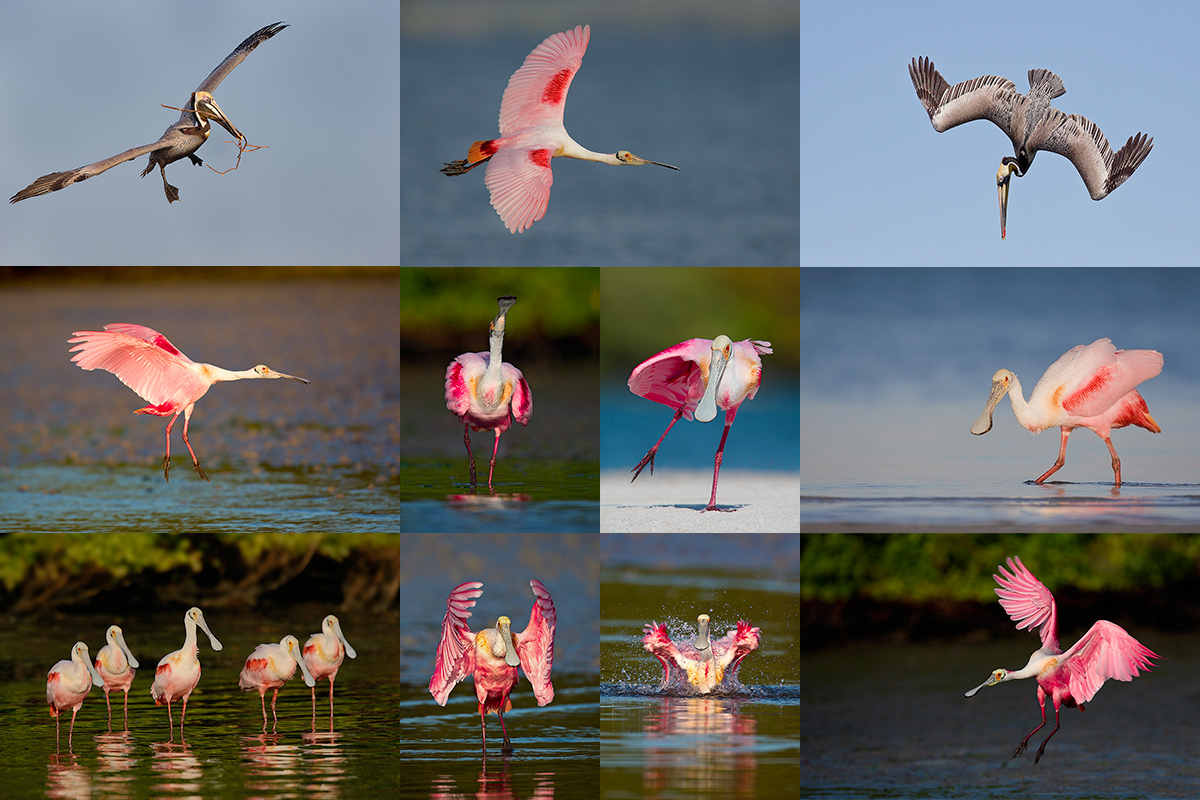Stuff
My San Diego to MCO flights were a breeze. After getting up before the 3am alarm I slept two hours on the first leg to DFW. With rain in Orlando getting my two checked bags took more than an hour. After a stop at Publix we (Jim and I) made it back to ILE just before 7pm. This blog post took 2 1/2 hours to put together and was published at 7:30am on Tuesday.
I have tons more on the 100-400II and the 7D II and lots more Southern Ocean and San Diego images to share with you here and will be doing that on a daily basis.
Roseate Spoonbill/Hooptie Deux IPT Opening
Due to a recent cancellation, there is a single opening on this IPT. Scroll down for details.
South Georgia October 2015
Do consider joining me in South Georgia next October for the trip of a lifetime. See here for the complete details.
Save $242
Register now for the South Georgia trip and receive a $242 on your return airfare. Please e-mail for details.
Please Remember to use our Affiliate Links 🙂
To show your appreciation for my continuing efforts here, we ask, as always, that you use our the B&H and Amazon affiliate links on the right side of the blog for all of your purchases. B&H is recommended for you major photography gear purchases, Amazon for your household, entertainment, and general purpose stuff. Please check the availability of all photographic accessories in the BIRDS AS ART Online Store, especially the Mongoose M3.6 tripod heads, Gitzo tripods, Wimberley heads and plates, LensCoats and accessories, and the like. We sell only what I have used, have tested, and can depend on. We will not sell you junk. We know what you need to make creating great images easy and fun. And we are always glad to answer your gear questions via e-mail. I just learned that my account was suspended during my absence; it should be up and running by Monday at the latest.
I would of course appreciate your using our B&H affiliate links for all of your major gear, video, and electronic purchases. For the photographic stuff mentioned in the paragraph above we, meaning BAA, would of course greatly appreciate your business. Here is a huge thank you to the many who have been using our links on a regular basis and visiting the BAA Online store as well.
|
This image was created in cloudy bright conditions at La Jolla, CA with the hand held Canon EF 100-400mm f/4.5-5.6L IS II USM lens (at 330mm) and the Canon EOS 7D Mark II. ISO 800. Evaluative metering at zero: 1/160 sec. at f/16 in Av mode was a bit of an under-exposure. The image was lightened during conversion in DPP 4. Rig on the Black Rapid RS-7 Strap. One AF point to the left of the central AF point (manual selection)/AI Servo Rear Focus AF as framed was active at the moment of exposure (as is almost always best when hand holding). Click here to see the latest version of the Rear Focus Tutorial. Click on the image to see a larger version. Image #1: foot of immature Western Gull |
100-400 II Close Focus
The minimum focusing distance (MFD) of the new 100-400 II is an incredible .98 meters or 3.2 feet. This yields at magnification of .31X, by far the largest of any Canon telephoto lens, surpassing the old magnification champ, the Canon EF 300mm f/4L IS USM lens (.24X). Consider that my once-beloved old “toy lens,”, the Canon EF 400mm f/5.6L USM lens focused only down to 3.5 meters or 11.48 feet and you can begin to understand the incredible accomplishment of the Canon lens designers and engineers.
What does this do for nature photographers? It opens up a whole new world of potential subjects including butterflies, dragonflies, grasshoppers, mayflies, and many other medium-sized and large insects of various species, frogs and toads, a great variety of flowers, avian head portraits (without needing a TC), tight feather detail images, and yes, even tight foot fetish shots. Of a single gull foot. Like the image above of the foot of a young Western Gull.
Another often overlooked advantage of a smaller MFD i the ability to point the lens straight down at small subjects on the beach or the ground while standing. This often allows you to parallel the subject. In the past, with the Canon EF 70-200mm f/2.8L IS II USM lens (MFD 1.2 meters of 3.94 feet/.21X magnification), that was often impossible.
Please feel free to leave a comment listing other small subjects that I left off my list that can be photographed with the new 1-4.
4-Stop IS
The amazing 4-stop Image Stabilization system introduced with the Series II super-telephotos seems to have been improved with the 100-400 II. With the 7D II I was hand holding at effective 528mm. At 1/160 second. The old guideline of needed a shutter speed of 1 over the focal length is way out the window for those using decent sharpness techniques. Combine the great IS system with the mind-boggling sharpness of the new 1-4 and more new worlds are opened up for nature and wildlife photographers.
|
This image was also created in cloudy bright conditions at La Jolla, CA with the hand held Canon EF 100-400mm f/4.5-5.6L IS II USM lens (at 176mm) and the Canon EOS 7D Mark II. ISO 800. Evaluative metering +1 2/3 stops: 1/1000 sec. at f/7.1 in Manual mode was spot on. Rig on the Black Rapid RS-7 Strap. Rear Focus/Zone AF selected an array of four AF points that fell on the bird’s bill and just below the bird’s eye. They were of course active at the moment of exposure (as is almost always best when hand holding). Click here to see the latest version of the Rear Focus Tutorial. Click on the image to see a larger version. Image #2: head of screaming adult Western Gull |
More 100-400 Versatility
Note here that the bird was so close that I needed to zoom out to 160mm…. Next time I will try zooming to 400mm and doing a real eyeball shot.
Image Question
Why f/7.1 for this image?
Your Favorite?
Please take a moment to let us know which of today’s two images is your favorite. Be sure to let us know why.
|
Images courtesy of and copyright Captain James Shadle (aka Froggie). All of the images here were created at Alafia Banks. Card creation and design by Arthur Morris/BIRDS AS ART. |
The Hooptie Deux/Roseate Spoonbills and More Instructional Photo-Tour via pontoon boat. 4 1/2 DAYs: $3200. SUN FEB 22 thru lunch on THUR FEB 26, 2015/Strict Limit: 6 photographers/Openings: 1.
Due to a cancellation we now have a single opening on this trip which sold out minutes after being announced.
Meet and greet on the evening of SAT 21 FEB. Two great leaders: Captain James Shadle (Nikon) and Canon Explorer of Light Emeritus Arthur Morris.
Roseate Spoonbill is one of if not the most sought after avian photographic subjects in Florida. They are generally hard to find and somewhat difficult to approach. They are relatively easy to find at Alafia Banks—heck, you can’t miss seeing them, but even there they can on some days be somewhat difficult to approach. On some days we may be able to get ridiculously close to them. The huge incentive to get out to Alafia Banks in mid-February is the chance to photograph this species at the height of its spectacular breeding plumage….
Weather permitting there will be nine boat trips: 5 mornings and 4 afternoons! Mornings to Alafia Banks for spoonbills and Brown Pelicans (with lots of flight photography with the birds likely carrying nesting material), cormorants, ibises (both Glossy and White in breeding plumage. Many of the White Ibises will be sporting their spectacular, distended, red, naked (un-feathered) throat pouches—typically larger in the females. In addition we will get to photograph egrets including Great and Reddish, both in full breeding plumage, shorebirds, and more. There will be lots of flight photography opportunities. Afternoon trips either to Alafia Banks for spoonbills and more or to a more sheltered inland rookery location for a variety of nesting birds. In the event of horrific weather artie will either take the group to Fort DeSoto or will conduct an image review/Photoshop session. This IPT includes five lunches that will be followed by small group image sharing and review and some over-the-shoulder Photoshop instruction.
Important Notes
We stay in Brandon, FL for this IPT. From our hotel there it is is only about 20 minutes to the dock. The plan is for all nine sessions to be by boat. For the Alafia Banks segments, Captain Shadle provides light weight chest waders as much of the photograph will be done while we are standing in fairly shallow water behind our tripods. We help you get in and out of the boat with your gear. This is likely not the best trip for folks with balance problems. Note however that some folks may opt to stay on the boat. They usually have lots of chances for flight photography of spoonbills and other species but are almost always pretty far away from the spoonbills that land.
I recently saw a similar trip advertised two months too late for breeding plumage spoonbills (and two months too late for most of the rest of the species in breeding plumage). 5 Days: $3200. With only four boat trips…. The Hooptie IPT represents an incredible opportunity and with 3 slots filled already the remaining three spots should fill very quickly. We hope that you can join us. Scroll down for registration info.
|
All of the images here were created at Alafia Banks in the month of February. Images copyright Arthur Morris/BIRDS AS ART. Card creation and design by Arthur Morris/BIRDS AS ART. |
Hooptie IPT Registration Info
A $449 non-refundable deposit is required to hold your slot for this IPT. Your balance, payable only by check, will be due on 11/22/2014. If you cancel and the trip fills, we will be glad to apply a credit applicable to a future IPT for the full amount less a $100 processing fee. If we do not receive your check for the balance on or before the due date we will try to fill your spot from the waiting list. If your spot is filled, you will lose your deposit. If not, you can secure your spot by paying your balance.
Please print, complete, and sign the form that is linked to here and shoot it to us along with your deposit check (made out to “Arthur Morris.”) You can also leave your deposit with a credit card by calling the office at 863-692-0906. If you register by phone, please print, complete and sign the form as noted above and either mail it to us or e-mail the scan. If you have any questions, please feel free to contact me via e-mail.
Be sure to like and follow BAA on Facebook by clicking on the logo link upper right. Tanks a stack!
Support the BAA Blog. Support the BAA Bulletins: Shop B&H here!
We want and need to keep providing you with the latest free information, photography and Photoshop lessons, and all manner of related information. Show your appreciation by making your purchases immediately after clicking on any of our B&H or Amazon Affiliate links in this blog post. Remember, B&H ain’t just photography!
Amazon.com
Those who prefer to support BAA by shopping with Amazon may use this link:
Amazon Canada
Many kind folks from north of the border, eh, have e-mailed stating that they would love to help us out by using one of our affiliate links but that living in Canada and doing so presents numerous problems. Now, they can help us out by using our Amazon Canada affiliate link by starting their searches by clicking here. Many thanks to those who have written.
Typos
In all blog posts and Bulletins, feel free to e-mail or to leave a comment regarding any typos or errors. Just be right :).


















To keep the bill in focus
Yes, sort of…. Via extra depth-of-field. a
Wild guess re: f7.1. Provides a greater depth of field in case gull swings head towards you (closer to you). This is also why you want AF active at moment of exposure.
All good. a
Re the F7.1, the head angle is more than 3 degrees
Good job. Why not f/11? a
Since he was screaming, you wanted to keep the shutter speed fast. I have a great idea to increase your workload:). You could state which shot you saved from the “rip”. Like: #2/10, second shot of a 10 shot sequence.
In part correct, but you missed the main reason. Check out the focal length…. As for the tip, I will pass it along to my blog assistant. Oh, wait, I have no blog assistant…. a
Oh, my brain hurts! I suppose then it must have to do with the background.
Nope. Since I was working relatively wide at 176mm there was lots more d-o-f than if I had been working at 400mm…. Thus no need to stop down to the extreme…. a
Love that foot!
Many tanks. a
Yesterday you indicated that the head throw image (an amazing photo) was taken using “AI Servo Expand/shutter button AF was active at the moment of exposure (as is almost always best when hand holding).” Todays post indicated that “AI Servo Rear Focus AF as framed was active at the moment of exposure (as is almost always best when hand holding). I believe yesterdays statement was probably an oversight and the result of your very hectic schedule – but which do you prefer when hand holding?
Thanks for all your sharing.
The “is almost always best when hand holding” bit refers to have AF active at the moment of exposure not to either rear focus or shutter button AF. 🙂 a
ps: no oversight 🙂
At F7.1 you don’t have to worry about the f-stop changing as you zoom. Can’t wait for your instruction on the 3 IS modes. Thanks
Mike in CT
Mostly wrong on the f/7.1….. I could have been at f/5.6. Why f/7.1?
I may just have to break down and get the new 1-4.
“The amazing 4-stop Image Stabilization system introduced with the Series II TCs” I am sure you did not mean to say “TCs”
Thanks Bill. I meant the Series II super-telephotos. I have corrected my error 🙂
later and love, artie
Two sweet images, but I especially like the foot for its uniqueness. The small MFD of this lens sounds great. I remember taking my 400 5.6 out for the first time several years ago and thinking my camera was broken because I couldn’t focus 🙂
:). To take full advantage of a given lenses MFD be sure that the limit range switch is set to Full…. a